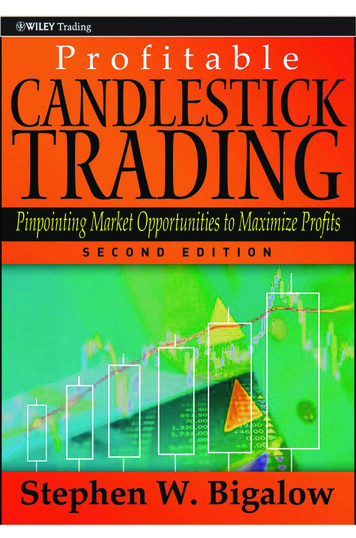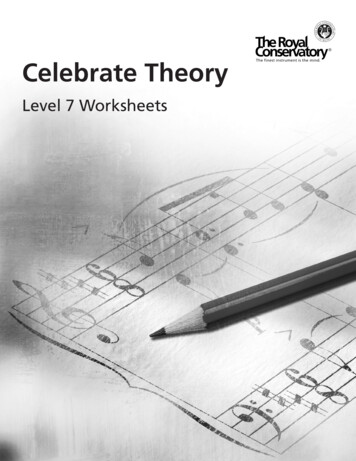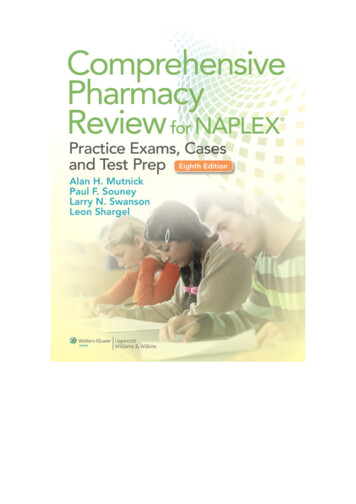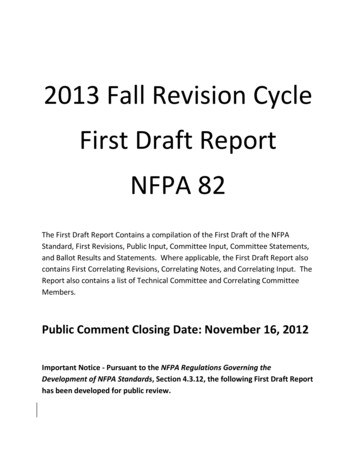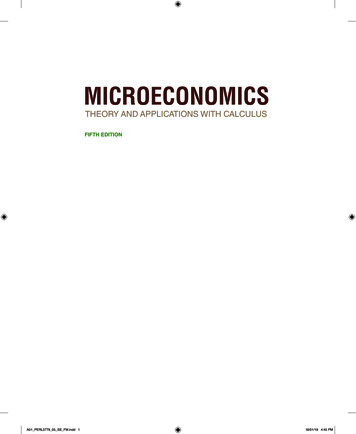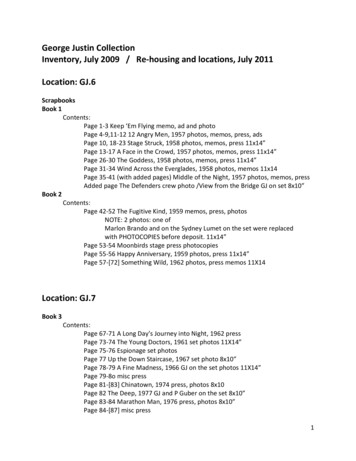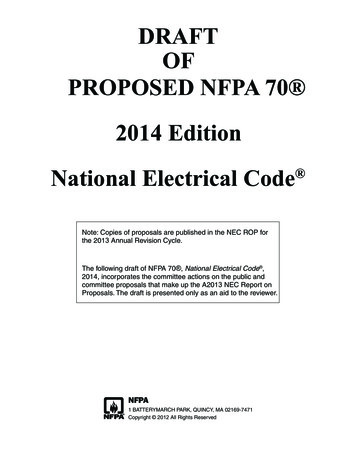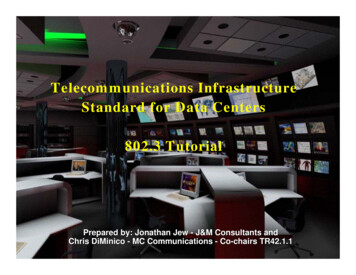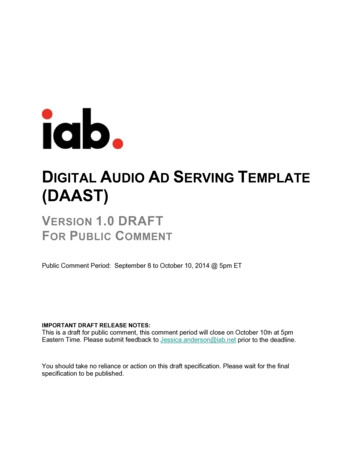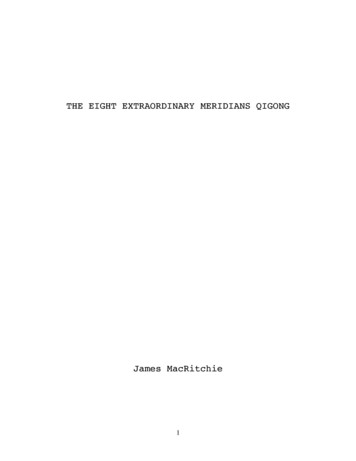
Transcription
THE EIGHT EXTRAORDINARY MERIDIANS QIGONGJames MacRitchie1
What’s in a name?Qigong, Chi Kung, Chee Gung.‘Qi’ is also at times written as ‘Chi’,but is pronounced ‘Chee’.‘Gong’ is also written as ‘Kung’and ‘Gung’.‘Qi’ means Energy, Vitality or Life.‘Gong’ means Working, Developing or Cultivating.So, Qigong can mean‘Working with Energy’‘Developing Vitality’or‘Cultivating Life’The author’s preferred term,and the titles of his books, is Chi Kung- however Qigong is used in this document because it isnow the predominant term in use internationally.2
Hello, and Welcome to this document on Qigong.I hope this information is as valuable to youas it has been to me, and many others.Qigong increases the energy and lifeinside you.Try it, and find out for yourself.Jim MacRitchie3
About This DocumentThis document is a PDF files, which means that the pages are fixed,as if they were photocopies, and cannot be changed. The pagedesign and layout is important to illustrating and understandingthe information.It has been designed to be used in a number of ways.- You can just read it off the computer.- You can print out on your own printer - section by section, oras one complete document.- It can be sent by email, or downloaded and taken to a photocopyor printshop who will print and bind it.- It can be printed out as a complete double-sided book.- It is designed with odd numbered pages on the right side, andeven numbered pages on the left, so that double-page spreadsface each other, therefore there are some blank pages in places.Please set your computer display to show it this way.- You can also send it to anybody, anywhere, over the internet,the world wide web, as it is condensed into a very small filesize of just over 1 megabyte, about the size of an averagephotograph. It can be sent as a simple ‘attachment’.- An audio version is available, where the practices are led asif you were in a class. Details are in the Afterword section.This material is copyrighted, but there is no charge or cost. Ifyou are reading this it belongs to you, and you can pass it on orgive it away to whoever else you think would benefit from learningabout Qigong and doing these most valuable practices.Good Wishes.4
Part IAN INTRODUCTION TO QIGONGPart IITHE EIGHT EXTRAORDINARY MERIDIANSTRAINING PROGRAMBook ReviewQIGONG FEVERBody, Science and Utopia in ChinaDavid A. Palmer5
AN INTRODUCTION TO QIGONGPreface- What Is Qigong?- Your Energy System- How It Works- A Language Of Energy- Applications- Qigong In Everyday Life- The Environment and Ecology- The Future Of Qigong- Summary- Practices To Experience Your Own QiAfterword6
PREFACEIt is strange to say that if you are a ‘Westerner’ you maybe reading about Qigong for the first time, but if you are an‘Easterner’ this will be as familiar as breathing, eating andwalking.How can this be, that part of the world knows about Qigong sinceearliest pre-history, and another major part of the world is nowhearing about it for the first time?Being a Westerner myself I asked that question, and came up withsome remarkable answers.But, before proceeding, I should state that by ‘West’ and ‘East’I do not mean geographical locations. These terms are used inthe way they have commonly come to describe the cultures thatdeveloped from Greco-Roman tradition, and those that originatedfrom China - they are used here in that general sense.The three most surprising answers were:First, this knowledge has been held in secrecy in China and theEast - reserved for the aristocracy, monks, doctors, martialartists and the most privileged. It was taught by word of mouth.Everybody knew about it, but only the elite few knew how to doit. This was one of their most precious possessions, and a sourceof power and authority, and they guarded it jealously.Secondly, there is no knowledge or understanding of the humanEnergy System in the West, there is no tradition or history - fora variety of questionable reasons. There is no equivalence toAcupuncture and the energetics of Oriental medicine, which formsthe basis of Eastern health care, fitness and spirituality. Thereis nothing to compare it to in the West.Thirdly, the organization and architecture of the mind andthought is different. The language and writing is different.Quite simply, the East and the West think differently. Andtherefore the two traditions experience themselves, and theirrelationship to the world and nature, in different ways.7
In fact, it may be that the understanding of Qi/Energy is theprimary difference between East and West.There are, no doubt, many other reasons why the West has notknown about Qigong, but in the observation and experience of thisauthor these are some of the main ones.However, with the opening up of the world over the last century,and now instant global communication and the Internet, thisinformation can be spread and shared in a way never beforepossible. The first book this author wrote on the topic, whichis embedded in this document, had to be written, designed andprinted on paper, sailed across oceans in ships, trucked inlorries to warehouses, to eventually be unpacked from boxes andplaced on shelves in bookstores, in the hope that somebody wouldbuy it - usually to cover the cost of the above procedure. Thiswas in 1993 - just 15 years ago.Now, if you are reading this document it is yours. It belongs toyou, right now. You own it. And you can send it to anybody youwish, anywhere in the world, at the touch of a button.The most important and closely guarded secrets of one of theworld’s oldest cultures have now become instantly available forfree.Why Free? Because the world needs this knowledge now. If I tried to sell it, you may not get it. or be able toafford it. It is copyrighted through GNU Free Documentation License, butthere is no charge or cost for its use. And because Qigong has important personal, social and globalconsequences.On a personal level it is about health and well-being, relieffrom pain, suffering and illness, aging well, clarity of mind,and promoting peace, happiness and long life.8
On a social level it is about understanding more of yourrelationship with the energy of the community, society andculture around you, and how they effect and interact with you and vice versa.On a Global level it is about correct function and management ofyour own energy system, to maximize its operation and efficiency,and minimize the need and use of external energy sources and theenvironment. It addresses 50% of the Global Energy Crisis - ourown personal energy.It is about understanding what we truly are, and how we reallywork, and what we can do about it. It is about emotional,psychological and spiritual health. It is about each person beingat their best.Qigong is the missing piece of Western civilization.But it has not been much available in China itself either, for avariety of reasons.China is complex, and quite different from the West. The Chineseare justly proud of their long history and accomplishments, andtheir new status as a world leader. But they do things differentlythan in the West. China was ruled by Emperors for the whole ofits 2,000 year history, until the last century. It has neverbeen a democracy. Power has always been from the top down,not the bottom up - it has never been any other way. This hasrecently caused considerable misunderstanding and friction withthe West in the areas of human rights and freedom.The simple truth is that the Chinese authorities just don’t ‘get’Democracy. They do not understand it because they have neverexperienced it. It makes no sense to them - for them the leaderslead, and the people do what they are told. Their social systemis Authoritarian, and it has always been that way.The story of Qigong in China over the last 60 years and itsinteraction with Governmental Authority is fascinating, and isdescribed in the excellent book ‘Qigong Fever - Body, Scienceand Utopia in China’ by David Palmer who looked at it all froma sociologist’s point of view. It tells the whole story of whathappened, from the ‘discovery’ by the Communist troops in9
World War II, through the wide-spread popularity as a ‘massmovement’, the scientific research and the opening of Qigonghospitals and clinics in the 1970s and ‘80s, to the crack down inthe ‘90s. What happened may be best summarized in the followingquote:“The Qigong Movement was born during the Mao era, reached itszenith in the post-Mao reform years of Deng Xiaoping, andimploded under Jiang Zemin”.‘Qigong Fever’ is fascinating reading and should be read byanybody seriously interested in understanding what actuallyhappened in recent years to Qigong in China itself. There is areview of this book by myself, which is attached at the end ofthis document for those people interested.Hopefully the following ‘Introduction to Qigong’ and theaccompanying ‘Eight Extraordinary Meridians Qigong TrainingProgram’ will give you an overview to what you can do toenable you to practice Qigong yourself, as it already has forhundreds of students. It is the product of 30 years practiceas a Classical Acupuncturist, 25 years teaching Qigong, andtwo trips to China. It is the condensed version of three bookson the topic. It is the result of creating the National Qigong(Chi Kung) Association USA, attending multiple internationalconferences, studying with numerous teachers, and being as widelyexposed as possible. It is the author’s life’s work to date.For whatever it is worth to you, and whatever sense it makes toyou or questions it answers, it is given in respect and gratitudefor having learned this work from my various teachers and thelineage of the tradition.And it is given in the spirit of a personal gift to whoever mayreceive it, to pass on to you the most important thing that wasever given to me, one of the greatest secrets of energy and life- Qigong.James MacRitchieBoulder, Colorado.Summer 2008.10
AN INTRODUCTION TO QIGONGWHAT IS QIGONG?In translating from Chinese into English there is not a singleequivalence of one word into another. There are often multipleinterpretations. Qigong does not have a singular exact meaning,not least because there is no equivalent or comparison inthe West.‘Qi’ means Energy, Vitality or Life.‘Gong’ means Working With, Developing or Cultivating.So, Qigong can mean- Working with Energy,- Developing Vitality, or- Cultivating Life.It is a collective name given to a vast array of practices thathave been developed over 2,500 years, by one of the world’soldest cultures. At the time of writing it is not the year 2008in China, but 4706.There are different styles, traditions, systems, schools,teachers. all with their own unique way of doing it.There are hundreds, some say thousands, of forms of Qigong. Thecomparison could be with music or dance. How many ways are thereto play the piano or move to music?11
Most Qigong are external forms of movement and exercise, whichare known as ‘Wei Gong’. Others are internal, similar tomeditation, and these are known as ‘Nei Gong’.Nei Gong is the basis of the accompanying set of practices calledEight Extraordinary Meridian Qigong.However, all of the styles of Qigong have one thing in common,one fundamental basis that they all share - the human energysystem. They all operate and function in terms of the anatomyand physiology of the energy system, its structure and function,which follows as exact and specific principles and rules as all ofthe other human biological systems.Following is an brief overview of this energy system.YOUR ENERGY SYSTEMThe energy system according to Qigong is mostAcupuncture. However, it should be noted thatnot the name this practice is called in Chinacalled Zhen Jou, which translates simply intofamiliar through‘Acupuncture’ is- there it isNeedle and Heat.The name Acupuncture was apparently invented by a Jesuit priestwhen he saw it being performed in China in the 11th century. Ithas now become mainstream in Western cultures and can be foundanywhere. Acupuncture has been a virtual revolution in healthcare in the West in the past 50 years. When the author began hisAcupuncture practice in Boulder, Colorado, a city of 100,000people, just over 25 years ago/a mere quarter of a century, hewas the only registered practitioner in the town - now thereare over 100 practitioners fully licensed by the State, and twoschools. The reason for this is very simple and straightforward- it works, because it works with the Energy System that is thecontrol system or blueprint for everything else.Qigong does the same, except that you do it yourself. It is goingto be a similar revolution as Acupuncture, but in Self Care.The energy system consists of pathways or lines of energy whichare called Meridians or Channels. Please take note that theterms pathways, meridians and channels are interchangeable, andmay appear in different ways in this document. In Chinese, a wordcommonly used is ‘Mo’, as in ‘Du Mo’ or ‘Ren Mo’.12
There are 20 major channels.Twelve of these relate to specific internal organs or functions,which are: Heart, Small Intestine, Bladder, Kidneys, Pericardium,Triple Heater, Gall Bladder, Liver, Lungs, Large Intestine,Stomach and Spleen. Along each meridian are ‘points’ which havevery specific functions.The 14 Main Meridian ChannelsEight of these channels are known as the Extraordinary Meridians.Of these ‘8 Extras’ only two have points of their own - theothers leapfrog and criss-cross over the points on the otherchannels.13
The Eight Extraordinary MeridiansGovernor/Du MoConception/Ren MoBridge/Yang Qiao MoBridge/Yin Qiao Mo14
The Eight Extraordinary MeridiansBelt/Dai MoThrusting/Chong MoLinking/Yang Wei MoLinking/Yin Wei Mo15
These 8 Extras are divided into two sets of four each - a primaryset and a secondary set.The four primary ones operate within the torso, and are known as:-Governor Channel/Du Mo,Conception Channel/Ren Mo,Belt Channel/Dai Mo, andThrusting Channel/Chong Mo.The four secondary ones, which back-up or support the primary setand run into the arms and legs, are known as:-Yang Bridge/Yang Qiao Mo,Yin Bridge/Yin Qiao Mo,Yang Linking/Yang Wei Mo, andYin Linking/Yin Wei Mo.These 8 Extras may be accessed and controlled by a specialgroup of points called the Master and Coupled Points, which aredescribed in detail later.Together with some sub-branches and connecting channels, these20 meridians/channels/pathways constitute the full number ofchannels in the body familiar in Acupuncture. Nobody has any moreor less.However, there is another set of important centers usedparticularly in Qigong. These are called the Three Tan Tien,which can be translated as The Three Elixir Fields or the ThreeEnergy Centers. These are located in the core of the body alongthe Chong Mo. They are located in the lower abdomen, the centerof the chest and the middle of the head.The Three Tan Tien contain The Three Treasures, which are knownas Jing, Qi and Shen, which can be translated as Essence, Energyand Spirit. The Three Treasures are considered to be the mostimportant possession a person has, and are nurtured, cultivatedand protected. See the accompanying illustrations and diagram.Qigong works by operating and affecting these channels and centers- to increase the volume and heighten the frequency of yourenergy, and put it under your conscious control.16
The Three Tan TienThe Union Of The Three Treasures- Jing, Qi, Shen17
HOW IT WORKSThere are basic laws and rules by which these pathways work.They are based upon the principles of the The Dao, which can betranslated as the Way of Nature.Daoism is one of the oldest philosophies in China. It predatesrecorded history. Daoism is concerned with understandingthe correct nature of events and how things work. It can beunderstood as the Chinese equivalent of the Western word,Science. In the same sense, Science can be understood asWestern Dao.There is another aspect of Daoism which became its religiousversion - there is a Daoist Church, with its own Pope, priests,nuns, temples and rituals, but none of that is described ortouched upon here. The Daoism described here is its secularnon-religious aspect.Daoism is described in the well-known books the Dao De Ching- ‘The Book Of The Way And Its Virtue’, and the I Ching ‘The Book of Changes’, amongst many other great classics.The Dao operates according to specific laws. There are many ofthese, with levels of subtleties, indeed there are scholars whodeal with nothing else. However, the primary ones used here are:Wu Ji, Yin Yang, The Eight Principles, The Five Elements, theTable of Correspondences, The Eight Trigrams and Wu Wei.18
Wu JiWu Ji means The Great Nothingness, the ground of all being, thatwhich existed before anything else came into existence.Yin YangYin Yang is the division into two separate poles, sometimescalled positive and negative. This is familiar through the wellknown symbol, which is now ubiquitous - from high philosophy toskateboards, medicine to earrings. There are five principles ofYin and Yang: Everything has a Yin and Yang aspect; Every Yin andYang can be further divided; Yin and Yang create each other; Yinand Yang control each other; Yin and Yang can each transform intothe other.The Eight PrinciplesYin and Yang polarity form the basis in Oriental Medicine of whatis known as The Eight Principles. This is a way of understandingand describing the state and condition of the Qi according toeight parameters. There are four pairs of opposites - Yin/Yang, Interior/Exterior, Deficiency/Excess, and Cold/Hot. Forinstance, a person may have an internal energy condition thatcould be described as yin, interior, deficient and cold -or- yang,exterior, excessive and hot. In a practical sense this allows fora way of thinking about a specific condition or situation, andtherefore to be able to decide on a course of action to take thatwould resolve the differences and then bring things back intocorrect balance.19
The Five ElementsThe Five Elements are known as Wood, Fire, Earth, Metal andWater. This is a way of understanding and describing the natureof things in basic categories according to their inherentqualities. There are many ways in which the Five Elements caninteract together, and these differences form the basis for wholeschools of thought in Daoism.It is perhaps easiest to understand the Five Elements inrelationship to the seasons of the year. The succession of theseasons is the basic condition under which all life has evolved.This is so fundamental that we tend to not even notice it asbeing our primary pre-condition; just as if we asked fish what itwas like to swim in water, they might answer, incomprehensibly“What’s water?”.The seasons are based on the rotation of the Earth around the Sunat approximately a 23.5 degree angle off its axis. Some currentscientific opinion is that this angle is caused by the gravitationeffect of the moon. The seasons always follow the same sequence,always have and always will. They never miss one, or jump one,or go in the opposite direction. They are stable and predictableand provide the basic metronome of life. Although in the West weconsider there to be four seasons, in Daoism there are five. Thefamiliar Western sequence is Spring, Summer, Fall and Winter;however, in the Daoist view it is considered that the period ofLate-Summer (sometimes called Indian Summer) is a separate anddistinct season of its own, the point of balance and harmony.20
Each of these seasons has a particular quality to it, whichreflects its character and nature. Each of these qualities isdescribed in terms of an Element or Phase. These Five Elementstranslate as Wood, Fire, Earth, Metal and Water. Wood is thepower or force which motivates things to grow in the Spring;Fire is the heat and activity which reaches a peak in Summer;Earth is the ground which provides a foundation for everything,reaching the center point of Late Summer; Metal is the mineralswhich return to the ground in Fall; Water is the snow and ice ofWinter.The Five Elements and seasons also have corresponding organsrelated to each one.- Spring/Wood is the Liver and the Gall Bladder.- Summer/Fire is the Heart and Small Intestines, and also thePericardium and Triple Heater.- Late Summer/Earth is the Spleen-Pancreas and the Stomach.- Fall/Metal is the Lungs and the Large Intestine.- Winter/Water is the Kidneys and the Bladder.The Five Elements21
In addition there are many more relationships of the FiveElements, including the emotions, which are illustrated in thefollowing Table of Correspondences.The Table Of Correspondences.This is the classical Chinese way of understanding our holisticnature and the relationship between all of our different parts.These relationships are expanded into many other aspects oflife, and provide the basic foundation for this comprehensiveand integrated way of looking at, and experiencing, the World.This way of seeing things ties all of the different aspectsof ourselves into one integrated and interrelated whole.For example: the physical level of organs, senses, tissues,functions; the emotional level of our basic feelings; the mentallevel of our abilities of planning, decision making, willpower,differentiation, sorting, control etc; and the various dimensionsand levels of our spirit.The Table of Correspondences also extends into the relationshipsof colors, sounds, odors, times of day, flavors, etc. It isan understanding of the relationships of all our parts, andtherefore is one of the original Holistic views of the world.It is Internal Ecology. It is worthy of our best attention andconsideration. It provides a foundation for an integrated viewand comprehension of who and what we are, and how we operate andfunction, which has withstood the most rigorous test and scrutinyof all - the test of time.22
The Five Levels of The Five Elements23
The Eight TrigramsThe Eight Trigrams, or ‘Ba Gua’, is a system of understandingthat describes the basic nature of change, how it works, and howto work with it. It is considered by some people to be a diagramof the primary dynamics of reality.The Trigrams consist of eight sets of three lines. The top linerepresents Heaven. The bottom line represents Earth. The middleline represents Humankind. These lines can be either Yang whichare unbroken, or Yin which are broken. The two primary trigramsare full Yang and full Yin, representing Heaven and Earth. Whenany of these lines change into their opposite, they create one ofsix possible permutations - Thunder, Water, Mountain, Wind, Fire,and Lake.The trigrams can be placed in particular relationships toeach other in the form of an eight-sided figure, the Ba Gua.There is an Earlier Heaven (Ho Tu) and a Later Heaven (Lo Shu)arrangement, which corresponds to the pre-natal and post-natalcirculations of energy.Later Heaven Ba GuaEarlier Heaven Ba Gua24
Wu WeiThe term Wu Wei describes an attitude to The Dao and life. Itis a way of looking at the world and what happens, and actingappropriately. Wu Wei has been translated as ‘non-action’ or‘non-interference’- however, in the opinion of the author thishas often wrongly been understood as meaning ‘doing nothing’. Onthe contrary, it means being in such Harmony with the Dao thateverything happens as it should, of its own accord. It may alsobe described as correctly understanding something in terms of itsenergy dynamics, and then taking the appropriate action.This has been called ‘The Water Way’, because the essentialnature of water is to fill whatever it comes to, and then keepon flowing. Sometimes it is indeed appropriate to not interfere,but at other times it is necessary to put every last ounce ofeffort and resources into something. You do the correct action/non-action in the situation. We all have the experience of doingsomething exactly right, so that it all went perfectly.This is Wu Wei.The State of HealthSo what is the state of energy-health? How is it measured,assessed, described?The state of correct functioning of your energy/control-system/blueprint can be described as when it works the way it isdesigned to, and how it is supposed to. This has five particularand specific characteristics that can be described as being whenyour energy has:1.2.3.4.5.BALANCE, andFREE-FLOW, withTHE RIGHT QUALITY,GOOD VOLUME, andCORRECT RELATIONSHIPSWhen you have these five characteristics then you have thenecessary foundation for the state of health and correctfunction. Your give yourself the Best Option.25
The PulsesAcupuncturists and Oriental Doctors can technically measure thiscondition by feeling/palpating 12 separate pulses on the wrists,as well as other indications such as a person’s color, the soundof their voice, the spirit in the eyes, the odor, the mannerismsand emotions etc. The pulses are a unique characteristic of themeridian system. They are the basic way in which the Chi in the12 major meridians, and therefore a person’s energy, is readand monitored clinically. Each of the 12 organs/officials has aseparate and distinct pulse, which can be felt and “read” by thefingertips of a trained and experienced practitioner. These pulsesare located on the radial artery of the wrist, and they may alsobe felt at the ankle and neck.There are three positions on each wrist, one at the normalposition for feeling the heart-rate pulse, opposite the styloidprocess, then another a fingertip in front of this, and the thirdposition a fingertip behind. In each position there are two levels— one superficial, the other deep, so therefore there are sixpositions on each wrist, making a total of 12 pulses altogether.This a most revealing and comprehensive technique, and it islimited only by the skill and experience of the practitioner.Reading ‘The Pulses’Pulse positions and their Correspondences26
A LANGUAGE OF ENERGYEnergy is Life, but a Language of Energy does not exist in theWest. To discuss the experience of Qigong we need an ‘EnergyLanguage’. Language gives us both a means of expressing andcommunicating meaning, experience, and sensation, and a way ofunderstanding these things ourselves.Without an Energy Language we have no way of describing andunderstanding our energy, or how to work with, control or developit. Without an Energy Language we are limited to vague, amorphouswords and strange gestures, instead of having meaningful,interesting and stimulating dialogues. Without an Energy Languagewe cannot discuss it with others or compare it with another’sexperiences.The way in which someone learns how their energy feels is byfirst doing a particular practice and then paying attention tothe effect, and thereby getting the feedback. In this way youwill build-up an Energy Language vocabulary and will slowlyand gradually create your own internal library of memories andrecords of how this feels. Doing the practices, reading thesensations, and remembering and recording them, is the best wayto learn. It requires a passive and receptive attitude of mind.This section proposes an ‘Energy Language’, to initiate andstimulate a dialogue between teachers, practitioners and others,and to devise a means of talking about energy experiences so thatpeople can discuss them in meaningful ways.Language, any form of language - movement, sound, images. is inherent in the structure, the hardware, of our brains; theimportant issue is how it relates to meaning, which in turnrelates to our internal sensations and feelings. A language isa means of expressing and communicating internal feelings andsensations.Qigong takes this one step further, by looking at how feelingsand sensations are based upon our internal energy states. Thiscould be simply described in the following diagram, whichoperates in both directions:Language Meaning Sensations and Feelings Energy State27
To develop a useable Energy Language in the West we need todescribe the meaning of the sensations and feelings of variousenergy states in simple, common and familiar Western terms.The following is a proposal for an Energy Language of sensationsand feelings, based upon classical Chinese principles of ourenergy anatomy and physiology, and upon principles the author hasfound to be true through personal practice and teaching.The four components of an Energy Language are:- Yin Yang,- The Five Elements,- The Percentage Scale, and- Volume Control.Yin YangYin and Yang are the two basic divisions of everything. Theyare the polarities. Someone mainly knows something by comparingand contrasting it against something else. Although thereare numerous ways that this could be defined, the three majorcategories discussed here are Quality, Movement and Position.Sensations of TinglingMurkyClearDarkLightSensations of isingStuckFlowingContractingExpanding28
Sensations of FrontBackCenterThe above are terms of quality, movement and position whichdescribe something in relationship to its opposite - its Yin andYang aspect.The Language Of The 5 ElementsThe 5 Elements, which are sometimes also known as the 5 Phases,are basic to the Daoist way of looking at the world. They are away of understanding the essence of something. They are not incomparison to an opposite, but a description of their own basicirreducible nature.The following is a description of the 5 Elements and the relatedorgans, temperature, color and direction.WoodFireOrgans:LiverGall BlTemp:EarthMetalWaterHeartSpleenSm. IntStomachPericardiumTriple n:RightUpCenterLeftDownThe two components of Yin Yang and 5 Elements constitute thefoundation of a language for describing your sensations.For example:A sensation can feel light, rising, strong, clear, on the right,warm and green.29
Or, heavy, sinking, full, at the bottom, murky, cold and blue/black.Or, flowing, yellow, on the left, mild, smooth and tingling.Any
Qigong, Chi Kung, Chee Gung. ‘Qi’ is also at times written as ‘Chi’, . This document is a PDF files, which means that the pages are fixed, as if they were photocopies, and cannot be changed. The page . It is copyrighted through GNU Free Documentation License, butFile Size: 1008KBPage Count: 186Explore furtherTaiji Qigong 18 Exercises - Free PDFtaiji-forum.comHow To Do The Eight Basic Movements Used In . - QiGongqigong.comThe Qigong Six Healing Sounds - Qi Gong Guide - Energy .www.energygatesqigong.usREIKI MASTER TRAINING MANUAL - Energy Healing For All www.energyhealingforallage Teach Yourself The Six Healing Sounds Qigong The .theconsciouslife.comRecommended to you b
